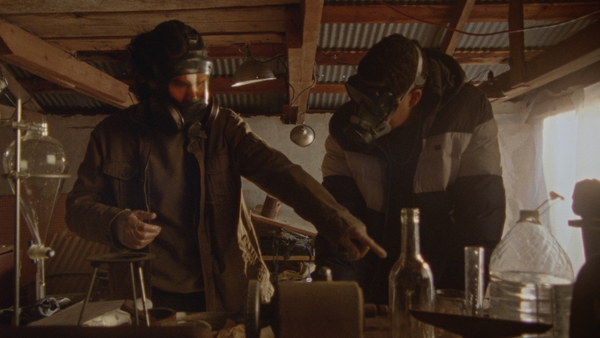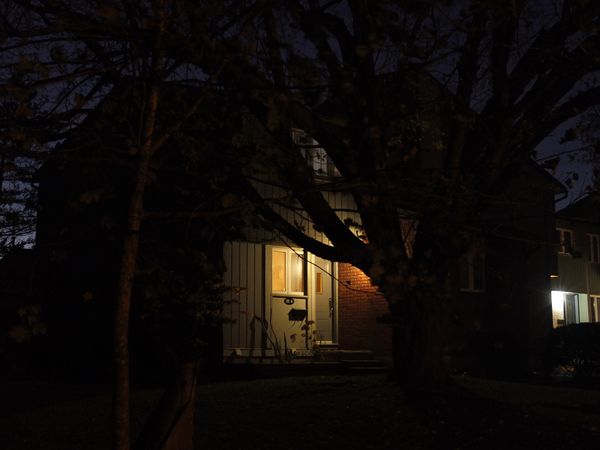On the night of January 7, sitting alone in my room, I hit play on the world’s longest movie.
I found the film by accident. Around that time, I was searching for something that could count as the longest horror movie ever made. The most viable contender I found was Douglas Gordon’s 1993 film installation, 24 Hour Psycho, which plays Alfred Hitchcock’s 1960 film Psycho at roughly two frames per second, amounting to a 24-hour viewing experience. But another film that kept popping up on the lists I searched is ultimately what caught my interest: Logistics Art Project.
Complaining about the length of Marvel movies is standard fare in our world. The longest of the bunch is currently Avengers: Endgame, which clocks in at three hours and one minute. Logistics, meanwhile, has a running time of 857 hours, or roughly 285 viewings of the Avengers film. If you wanted to watch Logistics in one sitting, you’d need to stay awake for 35 days and 17 hours. I’m one of likely just a few people to have watched the entire thing.
In 2008, Swedish artists Erika Magnusson and Daniel Andersson came up with an idea. As they describe on the Logistics website, they got fascinated with “the fact that the sourcing of just about every object in our surroundings involves almost inconceivable global logistics,” and wondered what those journeys looked like. They determined that in order to truly satisfy their curiosity, they’d need to track, in reverse chronological order, the journey of the “sort of anonymous clutter that everyday life is full of.”
Eventually, Magnusson and Andersson decided upon tracking the course of a pedometer they bought in Stockholm to the factory it was manufactured at in Shenzhen, China. They write that, “Four years later we found ourselves on the largest container ship in the world on our way from Sweden to China.” As per the trip: “We had started the journey by truck to Middle Sweden, then by freight train to the port of Gothenburg, and after four weeks at sea, we filmed from a truck again, this time from the port of Shenzhen to a factory in Bao’an.”

Logistics was first exhibited in December 2012 to January 2013 in Stockholm, in both the window of a cultural centre as well as a library. It would go on to be shown in China and Germany as well.
What made me hit play on Logistics — and keep watching — was a desire to encounter an extreme. As legendary filmmaker Andrei Tarkovsky wrote in his 1984 book, Sculpting In Time, the purpose of art should be to “prepare a person for death, to plough and harrow his soul, rendering it capable of turning to good.” If a silent, 857-hour movie with no recognizable plot or characters can’t do a little harrowing, what can?
The rental price of Logistics on Vimeo was a fair $15 USD, which is the best entertainment dollar-for-movie-hour ratio I’m likely to experience. The film has since been taken down from the service, however, which is a cinematic loss on a scale that’s hard to define. I feel like I’ve seen, maybe even sailed with, a ghost ship that I can now only speak of with the same cadence as other ephemeral legends.
My original goal was to live-tweet the viewing experience, but that didn’t quite pan out. Attempting to watch Logistics as a movie is nearly impossible, as it’s more of a commitment than a film. I needed to integrate Logistics into how I lived. Logistics is meant to be absorbed as an art installation, so why not install myself into it?
There came a point about three weeks into my viewing where the maddening, non-Euclidean shape of Logistics fully formed in my mind. I had an unnerving migraine. I could barely get myself together, let alone watch a boat not move for nine hours. I thought about quitting or taking a few days off, but then it occurred to me: the crew of the ship couldn’t quit, and the filmmakers couldn’t take a day off. I was now a part of this filmic thing, and I couldn’t stop until it was done.
From that moment on, Logistics became more of a job than my job. Each morning, I would roll out of bed, grab my tablet and clock in for my shift watching Logistics. It was on, in front of my eyes, while I worked, ate and lived. Logistics merged into my being, my life.
Logistics may have been birthed into this world in 2012, but the past few years have given the film a second life, with the pandemic laying bare the fragility of just-in-time logistics.
The film, in the words of its creators, strives to convey “in the most direct manner possible” the sheer slowness of physical freight that undergirds our ostensibly lightning fast, digital reality. It’s the inhuman watch time that makes Logistics truly sing. This is no trite documentary about oceanic commerce, no scold’s warning about the consumer’s responsibility for ethical shipping. It’s an attempt to encounter the thing itself.
The sheer weight of time that it took just to ship a pedometer from a factory to a store was crushing. The scale of human effort needed for such an effort is often reported in easily digestible and abstracted metrics such as person-hours or costs in dollars, but to watch it gnaws at the soul. Going on the Logistics journey means encountering a staggering depiction of alienation, isolation and just how much capitalist social relations have distorted our ability to understand time and space.
In Grundrisse, an unfinished text eventually published in 1939, Karl Marx first developed the idea that capitalist social relations have a way of compressing time and space. New technologies driven by the profit motive hasten the pace of everyday life until everything, from our labour to our love, is nothing but a blur.
This “annihilation of space by time” containerizes existence, but what if the way out isn’t slowing things down but rather giving them space? Logistics is the filmic annihilation of capitalist relations to time by a force of ultra-cinematic space. Logistics isn’t a feat of temporal duration, it’s a feat of spatial presence. To watch this film is not just to commit time, it’s to commit space in your life — space that becomes defined by the slow, silent pace of a container ship driven by capitalist productivity, but demanding that you reduce your own productivity to engage with it.
Cinema is an artform that is defined by the edit — choices in when we disrupt the normal flow of experiential time. Logistics has just four visible cuts in the flow of the journey, at the transitions from: a truck in Sweden to a train to the container ship and back to a truck when we reach our destination in the Bao’an District. Logistics takes a minimalist approach to editing to deliver a maximalist approach to mapping an experience.
This cinematic map is nearly the size of the actual trip. You can ‘fit’ a normal, 90-minute movie into your life by stopping at your local theatre, but you must bend the space of your life around Logistics. This film demands the viewer restructure how they use physical space just as much as it requires 857 individual hours.
The very living space of my existence throughout Logistics became part theatre, part crows nest and partly a mast to which I was willingly chained. The spatial relation between durational cinema and the physical activity of watching this movie created a momentary rupture in capitalistic spatial-temporal relations. Through watching Logistics, I was able to partly connect into the unknowably large network of labour that creates the physical goods that seemingly appear on store shelves by magic.
Marx may have failed to predict the joy I experienced when, on day 19 in the journey, the container ship reached the Suez Canal, but, in The Communist Manifesto, he did speak about the dark economic magic that enabled such a film, “like the sorcerer, who is no longer able to control the powers of the nether world whom he has called up by his spells.” Logistics emerges as an attempt to grapple with the runaway, nether world magic of capital. It’s certain that humans piloted the ship we follow, but those humans are in turn directed by the unseen market forces of capital.
Logistics might be a herculean feat of cinema, but it’s only a sliver of the real cost of capital. I got familiar with one boat in a sea of thousands of potential subjects. All over the world, similar ships, trucks and trains constantly writhe on the surface of the Earth to move the next generation of smart gadgets from factory to storefront.
Each of these vehicles has a person at the helm, but they are just as invisible under capitalism as they are in Logistics. In 857 hours of total silence, I can recall each moment a person entered the frame.
Our container ship makes regular stops at ports to exchange cargo. Each time we stopped, I would scour the frame for any sight of a human behind the cranes, forklifts and trucks taking cargo to and fro. I spent hours waiting to see one particular crane operator only for them to stop their crane stare directly down the barrel of the camera lens. I nearly cried.
The most beautiful moment in Logistics comes at one of the lowest points. Hundreds of hours of not seeing so much as a human-shaped silhouette, and then a deck hand stops dead centre in the frame and washes the windowpane that sits in front of the lens. Soap, bubbles and water wash down the frame. The world of containers and the open sea drift into a gentle, psychedelic haze.
A deckhand unintentionally created a beautiful work of art while hosing down a freighter. This was the only section of Logistics that I paused and re-watched. Are we nothing more than the caretakers of capital and its objects, or are we each capable of Earth-shaking beauty if only we had the time and space to realize our potential?
Nine hours a day was my target when watching Logistics. Some days I hit 13, while on others I fell short at around six or seven. All in all, I wound up finishing ahead of time, averaging just more than 10 hours a day, and taking about three months to watch the whole thing. I ended the journey on April 5.
You can get the “idea” of Logistics by watching an hour-long fan cut on YouTube, but the experience of this movie only realizes when it reaches hour 857. Time-space recompresses, and you snap back to a world moving so fast that it forgets the near-constant boat journeys required to put the latest gadgets in our hands.
The exact moment of finishing Logistics was a flurry of emotion. As far as the film goes, it just kind of stops: a truck pulls into a warehouse and then the camera cuts. But for me, it was pure ecstasy. For a moment, I just stared at a blank screen. Then the scope of Logistics hit me.
Alone in my apartment with just my cat to hear me, I was shouting in joy tinged with a small amount of sorrow. I realized that Logistics had become a part of my life and now it was gone. Perhaps even worse, the events of Logistics are still happening every minute of every day so Funko Pops can make it to your local shelves. Regardless of the effort this viewing experience took for me, it was ultimately just a glimpse into the lifetimes of countless workers.
My time on the freighter is over, but the ships are still sailing. In the midst of historic climate change, the pandemic and global political upheaval, our economic system is still ferrying trinkets across the globe. However, if Logistics showed me anything, it’s that time belongs to the working people of this world, when we can find ways to take it.






